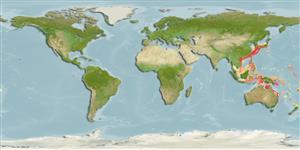Environment: milieu / climate zone / rango de profundidad / distribution range
Ecología
marino demersal; rango de profundidad 65 - 278 m (Ref. 50734). Tropical
Western Pacific: Japan and Taiwan to New South Wales, Australia.
Tamaño / Peso / Age
Madurez: Lm ? range ? - ? cm
Max length : 19.0 cm TL macho / no sexado; (Ref. 9792)
Radios blandos dorsales (total) : 66 - 72; Radios blandos anales: 51 - 57. Feebly pigmented snout, presence of supratemporal branch on lateral line of ocular side and medial dark pigmented spot on mandible and intermandibular area (Ref. 37532); lateral line on blind side absent; gill rakers on ocular side 3-6 + 7-13; caudal vertebrae 27-28; lateral-line scales on the ocular side 59-68; D 68-73, A 52-57, pectoral-fin rays on ocular side 8-10; caudal-fin rays 16-17; large ocelli on ocular side; pectoral-fin plain black or pale with black spots (Ref. 122002).
Body shape (shape guide): short and / or deep; Cross section: flattened.
Found in the sublittoral zone on sandy mud bottoms (Ref. 11230). Rare. Feeds on small benthic animals.
Life cycle and mating behavior
Madurez | Reproducción | Puesta | Huevos | Fecundidad | Larva
Hensley, D.A., 1997. Pleuronectidae. Righteye flounders. In K.E. Carpenter and V. Niem (eds.) FAO Identification Guide for Fishery Purposes. The Western Central Pacific. (Ref. 9792)
IUCN Red List Status (Ref. 130435: Version 2024-2)
Threat to humans
Harmless
Human uses
Pesquerías: sin interés
Herramientas
Special reports
Download XML
Fuentes de Internet
Estimates based on models
Preferred temperature (Referencia
123201): 11.1 - 26.4, mean 19.2 °C (based on 172 cells).
Phylogenetic diversity index (Referencia
82804): PD
50 = 0.5625 [Uniqueness, from 0.5 = low to 2.0 = high].
Bayesian length-weight: a=0.01585 (0.00587 - 0.04278), b=2.94 (2.71 - 3.17), in cm total length, based on LWR estimates for this (Sub)family-body shape (Ref.
93245).
Nivel trófico (Referencia
69278): 3.5 ±0.37 se; based on food items.
Fishing Vulnerability (Ref.
59153): Low vulnerability (10 of 100).
🛈
